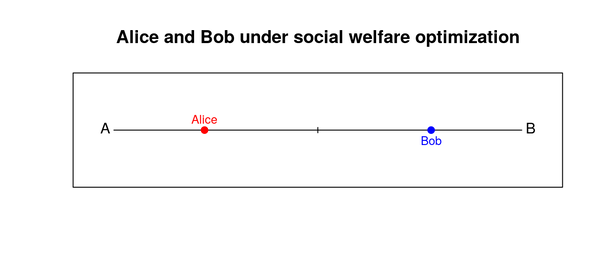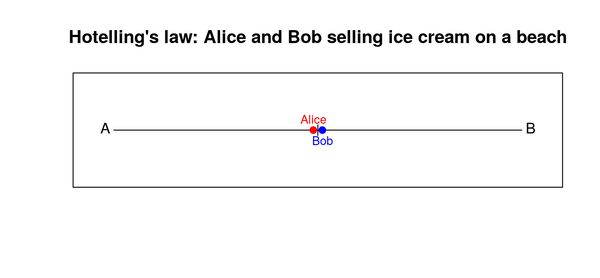15 March, 2024
by Mark Teisman
Back in university, I believe that it was in one of my first lectures on microeconomics where I got introduced to Hotelling's law. The law explains why competitors in a market often end up "clustering" together.
Imagine a beach that stretches from point A to point B. If Alice is the only ice cream vendor at this beach, she could position her shop anywhere along the beach and she would capture 100% of the market share. To keep the examples simple, from now on let's assume that beach visitors are uniformly distributed across the beach. Alice would optimize social welfare if she positions her shop at the halfway point between A and B.
Now imagine Bob also wants to set up shop, selling similar ice cream to Alice. Imagine the products (and service) of Alice and Bob are so undifferentiated, that beach visitors choose the ice cream vendor physically closest to them. In such a situation, you might be inclined to think that Alice and Bob would virtually split the beach in two, and settle in the center of "their turf". This is actually a solution that optimises social welfare, because it minimises the aggregate distance that customers would have to walk.

However, according this Hotelling's law, this may not be a stable solution. Alice or Bob would be able to capture a larger share of the market if they'd move their shop just a little bit closer to the center of the beach. Hotelling's law predicts that both Alice and Bob would ultimately both set up shop halfway between points A and B. Alice would be serving ice cream to all visitors between point A and the midway point, and Bob would be serving to the visitors between the midway point and point B.

Clearly, this is not great for social welfare. In fact, social welfare would almost be the same as it was under the situation where Alice alone was serving the entire beach (we're naively omitting the notion that a change in the number of vendors could have an impact on price of ice cream on this beach).
Anyway, the reason I write about Hotelling's law today is that I found it interesting to draw the parallel to politics. I find it interesting to reason about a parallel in the behaviour of political parties, particularly in a bipartisan system, as effectively exists in for example the United States, or in a runoff voting system, as Türkiye has for example.
In a two-party system, both parties may gravitate toward the median voter's position. They don't gravitate there because that median voter's position corresponds with the party's ideologies, but because by capturing the median voter you capture the majority of votes. The median voter is considered to represent the most common or average political preference. This is actually what's described in the Median Voter Theorem.
Unlike the beach where we had just one axis, while all political debate cannot be reduced to a single axis. The economic, social, environmental axes. The culture, health care and education axes. And so on. This is not easily placed on a single continuum. If a political party in a bipartisan election wants to capture the majority of votes, but does not want to gravitate away from its ideologies, then I see one opportunity: the party has to influence voters’ priorities. More clearly, the party has to make sure that the topic that this party truly stands for, becomes the topic that the median voter thinks about when she submits her vote. In the Netherlands, although we don't have a bipartisan system, in 2023 Geert Wilders successfully applied this strategy and for a significant part of the population made the elections about the topic of immigration.